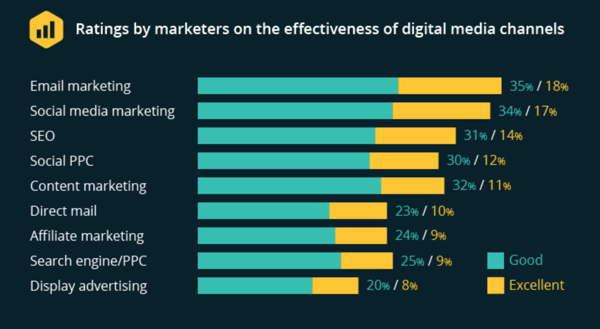Are you using the same email templates, lists, and marketing techniques that you were last year?
It’s easy to get stuck in an email marketing rut, especially when you have so many other marketing strategies to keep up with and many other things to worry about in a day.
However, it’s no secret that email marketing is highly effective when done well. According to a 2017 survey completed by Smart Insights and GetResponse, marketers rated email marketing as the most effective digital media channel.

With so much success possibly hiding in your email marketing campaigns, it’s important to audit them often and monitor and update them on a weekly basis.
Email marketing best practices and tips
Here are five email marketing best practices to make sure you’re keeping up with in the second half of 2018 and beyond.
Deep email segmentation & personalization
You need to keep in mind that your audience is not one-size-fits-all when it comes to email campaigns. There are different reasons why a person might be signed up for your emails, and you need to be taking those differences into consideration when creating your campaigns.
You’re probably already segmenting and personalizing your emails with a couple different lists, such as customers and leads or prospects, and maybe filling in some things dynamically, like the person’s name. That’s great, but how about going even further?
Think critically about your subscribers. What are their differences? Think about it and make a list of the largest differences between them, keeping specifics about your company or brand in mind. Once you’ve got your list, look at each point and get inspired for personalization and segmentation.
Here are a couple examples of differences, and how you might use them for email segmentation and personalization:
- Your customers have bought different products or services. You could segment and personalize based on what it is they’ve purchased, how long it’s been since they purchased, and whether they’ve made multiple purchases.
- Your subscribers have different interests. Segment and personalize based on what topics, products, or services they’re interested in.
- Your subscribers are mostly professionals, but hold different titles and positions. Segment and personalize based off of that information, if you have it or can glean it.
- Subscribers get different content based on what content they’ve clicked on in previous emails.
Email Automation
Automation, another important email marketing best practice, is a fantastic way to put your email campaigns to work for you. Everything we went over regarding segmentation and personalization can further benefit from adding automation. If you’re not doing automation, you’ll quickly find out how easily it can take things to the next level.
So, what exactly do we mean when we talk about automation?
Automation works with triggers. Someone completes some sort of action trigger, causing that person to be put into an email campaign. An automated email campaign runs based on the rules you give it. An easy example is when someone first signs up to your email list. You can have an automated welcome email series, subscribers first get an email thanking them for signing up, then another email three days later introducing them to your company or topic, another email four days later with an offer, and so on.
Here are just some of the ways you can think about automating (and further segmenting) your email campaigns:
- Emails sent after a purchase is made
- Subscribers get put in a different list after not having opened X number of emails in a row
- Automated emails for people who’ve added something to their cart but haven’t yet purchased
TIP: Learn about permission-based email marketing and how to best leverage it in 2019.
Awesome email visuals
Another email marketing best practice is to use engaging visuals in your campaigns. Email content is just like content on your website: it needs to be compelling and engaging. Your email will land in inboxes full of other emails. Why should someone give yours their time?
Use compelling visuals to get recipients clicking through to your site and reading the rest of your content or offer. Use:
Keep mobile in mind
According to eMailmonday, “Mobile email will account for 22-to-77 percent of email opens, depending on your target audience, product, and email type.”
That’s a pretty big number, no matter which end of that you’re on. Your email must be mobile friendly and compatible on every device.
So, while our previous point talked about using awesome visuals, they need to be optimized for mobile. This means they should be small enough in size to fit on a mobile screen in a responsive email template, and they need to be a small enough file to not cause extended loading times.
Beyond visuals, the rest of your campaign should be mobile-friendly as well. Keep content short enough to engage a short attention span, make sure calls-to-action (CTAs) and buttons are the right size, and above all, test! Test how your emails look on multiple devices.
Mobile-friendly emails are also more important depending on your industry. For example, it's much more important to have mobile-friendly email marketing best practices for ecommerce sites.
Email Analytics
Arguably, the most important part of email marketing is watching your analytics and tweaking your campaigns to make them work better.
Some important metrics to watch:
- Click-Through-Rate (on each element)
Use analytics to check on how all of your new practices are working. Are subscribers unsubscribing during a certain step in your automated campaign? Are they clicking on those personalized pieces you’ve added? Are they finding your content or offer relevant and compelling and clicking through to your site? When are the best times to send your emails?
Putting these email marketing best practices to work
Keep asking yourself these questions and striving to constantly make your email campaigns better, and you’ll have a marketing tactic that does really well for your business or brand.
Be sure to check out G2 Crowd's email marketing software category to research the best tools to manage your company's email campaigns.
 by Michael Bibla
by Michael Bibla
 by Michael Brenner
by Michael Brenner
 by Jeremy Rembulat
by Jeremy Rembulat